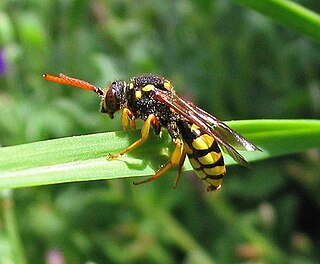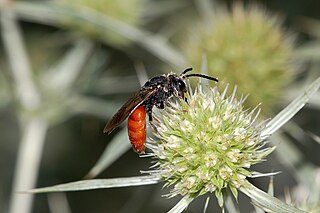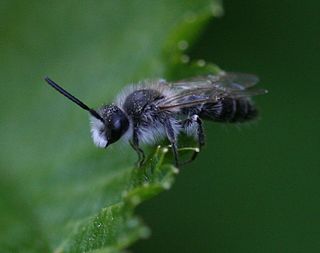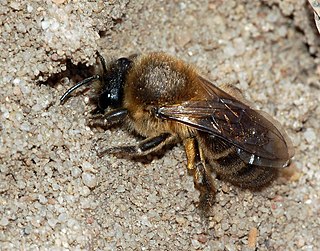
Halictidae is the second-largest family of bees. Halictid species occur all over the world and are usually dark-colored and often metallic in appearance. Several species are all or partly green and a few are red; a number of them have yellow markings, especially the males, which commonly have yellow faces, a pattern widespread among the various families of bees. The family is distinguished by the arcuate basal vein found on the wing.
Michael S. Engel, FLS, FRES is an American paleontologist and entomologist, notable for contributions to insect evolutionary biology and classification. In connection with his studies he has undertaken field expeditions in Central Asia, Asia Minor, the Levant, Arabia, eastern Africa, the high Arctic, and South and North America, and has published more than 760 papers in scientific journals and over 800 new living and fossil species. Some of Engel's research images were included in exhibitions on the aesthetic value of scientific imagery. Engel is the author of Innumerable Insects and co-author of Evolution of the Insects.

With over 850 species, the genus Nomada is one of the largest genera in the family Apidae, and the largest genus of kleptoparasitic "cuckoo bees." Kleptoparasitic bees are so named because they enter the nests of a host and lay eggs there, stealing resources that the host has already collected. The name "Nomada" is derived from the Greek word nomas, meaning "roaming" or "wandering."

Lasioglossum malachurum, the sharp-collared furrow bee, is a small European halictid bee. This species is obligately eusocial, with queens and workers, though the differences between the castes are not nearly as extreme as in honey bees. Early taxonomists mistakenly assigned the worker females to a different species from the queens. They are small, shiny, mostly black bees with off-white hair bands at the bases of the abdominal segments. L. malachurum is one of the more extensively studied species in the genus Lasioglossum, also known as sweat bees. Researchers have discovered that the eusocial behavior in colonies of L. malachurum varies significantly dependent upon the region of Europe in which each colony is located.

Sphecodes albilabris is a solitary parasitic bee that is endemic to Central and Western Europe. It also occurs in North Africa and is thought to have been introduced to the United States and Australia by accident. The larvae of this species are parasites of Colletes cunicularius.
Lipara is a genus of flies in the family Chloropidae. Among the Palearctic species, a specific community of bees and wasps make their nests in the galls of chloropid flies. Most frequently, they use the galls induced by Lipara lucens on common reed stems. Some of these aculeate hymenopteran species, such as the digger wasp Pemphredon fabricii (Crabronidae) or the solitary bee Hylaeus pectoralis (Colletidae) are specialized for nesting in galls induced by Lipara spp. more than a year ago.
Heinrich Friese was a German biologist and entomologist, specialist of bees (melittologist). Between 1883 and 1939 he described 1,989 new species and 564 new varieties or subspecies of insects, 99% of which were bees.

Dasypoda hirtipes, the pantaloon bee or hairy-legged mining bee is a species of solitary mining bee from the family Melittidae. It is a widespread bee which is found from Great Britain to China.

Epeolus cruciger, the red-thighed epeolus, is a species of cuckoo bee from the family Apidae. It is endemic to Europe, where its main host is the common colletes, although other species of Colletes mining bees have been recorded as hosts.

Adolph Schenck was a German entomologist and teacher.

Sphecodes is a genus of bees from the family Halictidae, the majority of which are black and red in colour and are colloquially known as blood bees. Sphecodes bees are kleptoparasitic on other bees, especially bees in the genera Lasioglossum, Halictus and Andrena. The adults consume nectar, but because they use other bees' provisions to feed their offspring they do not collect pollen.

Sphecodes gibbus, the dark-winged blood bee, is a species of cleptoparasitic blood bee from the Palearctic. It is the type species of the genus Sphecodes and was first described by Carl Linnaeus as Sphex gibba in 1758.

Andrena vaga, the grey-backed mining bee, is a species of solitary bee which is found in most of Europe but which is very rare in Great Britain, where it may be recolonizing in the south-east after previously being extirpated. It specialises in feeding on the pollen of willows.

Sphecodes davisii is a species of sweat bee in the family Halictidae.

Augochlorella is a genus in the bee family Halictidae, commonly called sweat bees. They display metallic coloration, ranging from reddish to gold to bluish green, as is typical for other genera in the tribe Augochlorini.
Sphecodes mandibularis is a species of sweat bee in the family Halictidae.

The bearded miner bee is a species of miner bee in the family Andrenidae. It is found in Europe and Northern Asia and North America. Other common names include the long-lipped andrena and the sandpit mining bee.

Colletes cunicularius, the vernal colletes or spring mining bee, is a species of solitary bee from the family Colletidae which is widespread in the Palearctic from Britain to the Pacific Ocean which nests in areas of open, sandy soil.














